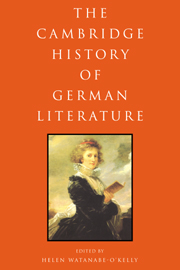Book contents
- Frontmatter
- 1 The Carolingian period and the early Middle Ages (750–1100)
- 2 The high and later Middle Ages (1100–1450)
- 3 The early modern period (1450–1720)
- 4 The German Enlightenment (1720–1790)
- 5 Aesthetic humanism (1790–1830)
- 6 Revolution, resignation, realism (1830–1890)
- 7 From Naturalism to National Socialism (1890–1945)
- 8 The literature of the German Democratic Republic (1945–1990)
- 9 German writing in the West (1945–1990)
- Select bibliography
- Index
- References
5 - Aesthetic humanism (1790–1830)
Published online by Cambridge University Press: 28 March 2008
- Frontmatter
- 1 The Carolingian period and the early Middle Ages (750–1100)
- 2 The high and later Middle Ages (1100–1450)
- 3 The early modern period (1450–1720)
- 4 The German Enlightenment (1720–1790)
- 5 Aesthetic humanism (1790–1830)
- 6 Revolution, resignation, realism (1830–1890)
- 7 From Naturalism to National Socialism (1890–1945)
- 8 The literature of the German Democratic Republic (1945–1990)
- 9 German writing in the West (1945–1990)
- Select bibliography
- Index
- References
Summary
Introduction
These years, which begin with Johann Wolfgang von Goethe’s maturity and end approximately at his death in 1832, used to be called the Age of Goethe. There were good reasons for this: the period contains most of Goethe’s major works, all of which display his characteristic tendency to embody the conflicts of the age refracted through his own, subjective experience and so claim representative status. Of course, this involved accepting Goethe’s absolute pre–eminence and taking only his view – for example, that Romanticism, one of the most widespread cultural tendencies of the age, was sick, so that Goethe’s Classicism had to fight it. In truth, even though Goethe remains the epoch’s outstanding writer, this kind of monolithic model no longer explains what we know of the literary situation and its development.
For example, the Enlightenment did not, as Goethe’s own Classic–Romantic dualism suggests, simply end with the onset of polemics against its rationalistic tendencies around 1795–6. August von Kotzebue (1761–1819), whose works dominated the German stage (including Weimar) from 1790 to well beyond his assassination, was a slavish (and, in a sense, masterly) imitator of Lessing’s Enlightenment dramas, to say nothing of Wieland, the father and son team of Voß, and a host of popular novelists. There emerged too a newly coherent body of literature by women such as Caroline Auguste Fischer and Karoline von Gunderrode. Nor is the epoch any longer clear cut. In the Biedermeierzeit (Age of the loyal subject–1815–48) an archetypal Romantic like Clemens Brentano assimilates central values of Restoration.
- Type
- Chapter
- Information
- The Cambridge History of German Literature , pp. 202 - 271Publisher: Cambridge University PressPrint publication year: 1997
References
- 3
- Cited by

